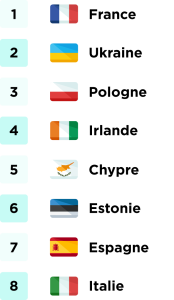Open Data Maturity Report: how mature are European countries?

Open data is vital to meet the growing needs of citizens, consumers and other stakeholders for increased public sector transparency. How are countries reacting to these demands? Learn more in the European Commission's 2022 Open Data Maturity report.
At a time when citizens, consumers and employees are all demanding greater transparency from public institutions, open data is becoming vital for successful government at a national and local level. However, many countries are not yet fully embracing open data. That’s the conclusion of the 2022 Open Data Maturity Report, published in December by the European Commission.
By assessing how each country is approaching open data, the study aims to help them demonstrate progress, find areas for improvement and benchmark maturity against other states. The study also provides an overview of best practices implemented across Europe, particularly those that enable countries to comply with the EU’s 2019 Open Data Directive.
Open Data Maturity Report: an overview of development in European countries
To assess the open data maturity of European countries, Data.europa.eu, part of the European Commission, studied 35 countries:
- 27 EU member states,
- 3 European Free Trade Association (EFTA) countries (Iceland, Norway, Switzerland),
- 4 candidate countries (Albania, Montenegro, Serbia, Ukraine)
- 1 potential candidate country (Bosnia and Herzegovina).
The European Commission established four topline assessment criteria, which it then applied to every country in the study:
- Policy
- Impact
- Portal
- Quality
What are the criteria used to measure a country’s open data maturity?
Its open data policy
This metric looks to understand each country’s government open data policies and strategies, while taking into account regional and local environments.
It examines the measures that are in place to encourage the reuse of open data by private organizations and public sector bodies. It considers different aspects:
- The implementation of a comprehensive open data policy: 96% of the countries have adopted an open data policy, and 74% have updated their strategy since 2021.
- The creation of an action plan to achieve the goals set out in a country’s open data policies.
- The actions taken to improve access to real-time, geospatial, and citizen-generated data (via APIs). Geospatial data and real-time data are a key topic in the 2019 Open Data Directive, which includes multiple measures to guarantee open data sharing in the public sector. It is therefore not surprising that 89% of EU member states state that their strategies include measures incentivizing the publication of, and access to, real-time or dynamic data.
- The measures put in place to support the reuse of open data: the aim of the 2019 Open Data Directive is to encourage open data reuse. For example, it mentions the importance of prioritizing high-value datasets (geospatial data, data related to earth observation and environment, meteorological data, statistical data, data related to companies and company ownership, and mobility data).
- The implementation of a governance strategy, which includes the creation of shared rules, but also the recruitment of data managers. This governance structure can be centralized (with a dedicated team in charge), decentralized (with units in each department), or even based on a hybrid model, as is the case in 70% of the EU member states.
The efforts being made to promote the reuse of open data: actions designed to facilitate the publication and reuse of data are also taken into account when evaluating maturity levels.
The impact of open data strategies within countries
In the 2022 Open Data Maturity report this theme has been restructured. The aim is to better distinguish between the simple reuse of data and the impact of sharing data through innovative products and services built on open data.
Several indicators are factored in: strategic awareness, the tools put in place to measure and understand the reuse of data, and the true impact. The Impact criteria is based on answers to key questions:
- Are countries aware of the benefits of opening data? For example, cost savings or environmental benefits such as improved air quality.
- How do countries measure the impact of their strategy and the reuse of their data?
- What are their open data maturity levels, in governmental, societal, environmental and economic terms?
The creation of open data portals
To help citizens, companies and administrations find public information, countries have created central open data portals. The Open Data Maturity Report analyzes different aspects of these:
- Portal features that will provide easy and rapid access to relevant content (using search engines, themed filters); make the data easier to understand (through visualizations, licenses); and enable their reuse (via APIs, downloads and metadata).
- Portal usage, analyzing the behavior of users and their usage by measuring indicators such as the number of API calls or downloads.
- Portal access management, whether providing specific access to specific, confidential information for certain stakeholders, or for publishing and reusing data.
- Portal sustainability, increasing long-term usage through communications and improvement programs based on user feedback.
Data quality
Open data maturity is measured through the quality of the data and metadata available. The data must therefore meet several criteria in terms of completeness , currency and compliance (in particular with the DCAT-AP metadata standard). To assess this aspect, the European Commission studies the governance and control processes that guarantee metadata quality.
- The quality of the metadata – this must be regularly updated and checked
- The processes in place to guarantee data quality, supported by open data licenses
- Compliance with DCAT-AP: this standard indicates the elements, rules and structures to apply when publishing datasets. It is one of the metadata models used by Opendatasoft.
- Data deployment, which must guarantee data quality and security.
What are the challenges in democratizing open data in Europe?
What are the obstacles to the democratization of open data?
After recovering from the global pandemic, European states must now tackle new geopolitical and economic challenges. For example, the war in Ukraine had direct consequences on the European economy and the energy market in 2022.
In addition to this international crisis, difficulties are emerging at the national level, such as:
- Lack of resources: this concerns both human resources, with many countries stressing the shortage of adequate open data skills, and financial resources, particularly around allocating a recurring budget to open data.
- Coordination issues: problems that stop different levels of government working together to promote smooth data sharing and management.
- Engagement with the topic: a genuine open data culture needs to be developed. This means incentivizing different public and private stakeholders to provide their data and reuse information that has been made available.
- Publishing data: more support, in legal, technical, and financial terms, is needed to encourage open data publication in most countries.
That said, challenges help spur the emergence of new solutions using open data. For example, the COVID crisis highlighted the importance of using open data to compile statistics and develop dashboards and warning applications. More recently, a number of players in the utility sector have invested in open data portals to deal with the energy crisis.
States are intending to accelerate their open data efforts
The Open Data Directive (Directive (EU) 2019/1024) encourages European states to promote the reuse of data in the public sector. This standard is expected to be adopted in each country by late 2022 or early 2023.
Overall, EU states are all ready to apply this directive, as these figures demonstrate:
- 96% of countries are identifying high-value data, such as statistics, geospatial data, earth observation, environment data, and meteorological data.
- 100% of states already promote this data on their national portal.
- 85% of states are preparing to measure the extent to which data is reused.
- 63% of EU member states are preparing to ensure the interoperability of their datasets with those of other countries.
European countries are therefore investing significant resources to increase their open data maturity. This bodes well for the opening up of data at the European level.
Which countries are the European pioneers in open data?
In addition to identifying top trends, the report draws up a ranking of the European countries with the highest levels of open data maturity.
France leads, with open data reuse across all sectors
France has the highest maturity level, a reflection of the efforts made by the entire French open data community and by organizations in a range of different sectors to democratize data use.
At Opendatasoft, we work with many pioneers who are leading the way in open data in their sectors:
- Local authorities: the cities of Paris and Rennes were among the first authorities to open up their data. Many other cities, metropolitan areas, departments and regions now share their data using our platform. These include, for example, the Ile-de-France, Pays de la Loire and Auvergne regions, the Mayenne and Pyrénées-Atlantiques departments, the Aix-Marseille-Provence, Lille and Clermont metropolitan areas, and the cities of Dijon and Orléans.
- Public institutions: Social security agency URSSAF and the Ministry of Culture were among the first central government institutions to open up their data to drive greater transparency and efficiency in steering public policy. The majority of ministries and public institutions, such as the Ministry of Economy and Finance, the Ministry of Sports, the Ministry of National Education and the Ministry of Health, have since followed their lead.
- Banking: the BPCE was the first banking group in France to open up its data.
- Energy: Enedis and EDF were the first French energy suppliers to open up their data to help better manage grids and support energy transition goals. Opendatasoft has been supporting this trend among energy providers for several years, most recently in Northern Europe, particularly in Great Britain and Ireland, working with operators such as UK Power Networks, Northern Ireland Electricity Networks, Scottish Power Energy Networks, Electricity North West and Northern Power Grid.
- Transport: The French railway company, SNCF, adopted Opendatasoft in 2016 to democratize its data internally and externally via an open data portal.
- Luxury sector: Kering group launched its open data portal in 2018 to communicate about the environmental impact of its business.
All these players are contributing to opening up data at the national level. This free access to information from different key sectors (such as banking and energy) encourages the creation of value for everyone.
Other pioneering countries
Besides France, the European Commission ranked other countries that are setting trends in terms of open data. These are countries with an excellent level in all the aforementioned fields: an advanced open data policy, strong coordination of activities at all levels of government, a portal with a wide range of features, and very high-quality data.
This is the ranking of the most mature European countries in terms of open data:

Best practices for turning your information into open data
Open data has established its importance over the last several years and is being adopted by an increasing number of private and public sector organizations. However, since regulations and trends in this area are evolving rapidly, it is vital to adapt strategies to incorporate the latest best practices to ensure success.
Understand your stakeholders’ needs and define use cases early
Innovative uses for open data are essential to deliver open data impact, which is why this criterion is becoming increasingly important in the Open Data Maturity Report. By starting with high value-added datasets and simple use cases, it will be easier to document strategic impact and actual results.
Several methods can be used to monitor the impact of data projects, such as through interviews with users, use cases, or log analyses from the national portal. The idea is to take country-specific parameters into account and to improve performance iteratively over time.
Define a solid governance strategy
The majority of the criteria assessed by the Open Data Maturity Report depend on solid data governance. This type of strategy helps guarantee that data is consistent (thanks in particular to metadata), complete (i.e., enriched and up to date), secure, used correctly (following defined standards while meeting stakeholder needs), and compliant with different regulations.
Continuously develop your open data portal
Open data is constantly evolving, as are user requirements. For this reason, it is important to gather their feedback regularly so as to improve your portal and how you present your data. This is crucial for creating impact, especially after the initial portal launch. Open data portals should be continually adapting, with new datasets, visualizations and use cases added over time.
Collaborate and share best practices across the entire sector
Collaboration is vital for creating new, innovative usages thanks to data. By discussing best practices and sharing their data on a large scale, European countries can find solutions to deal with the challenges they all face.
The prospects for open data in Europe
While European countries are not all at the same level of maturity, they definitely all demonstrate a willingness to develop their open data performance. The challenge for each country is to improve both its strategy and implementation (whether this is in terms of policy, impact, portal or data quality) at a national level. Moreover, wider collaboration should also help to strengthen open data across the entire European continent. The idea is to learn from each other and to spark new initiatives.
 Data Trends
Data Trends
How successful are governments at sharing their data with citizens and businesses? The latest Open Data Maturity report provides an overview of progress across Europe, and highlights the importance of improving data portals and measuring impact to future success


